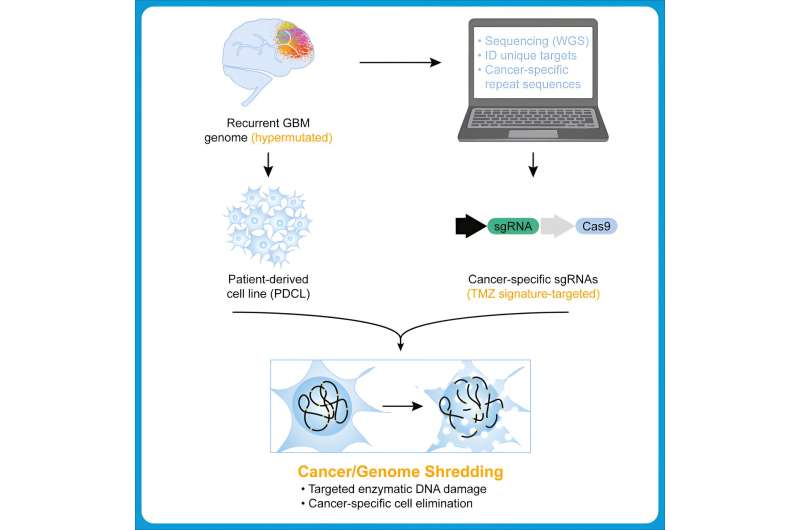This article has been reviewed according to Science X's editorial process and policies. Editors have highlighted the following attributes while ensuring the content's credibility:
fact-checked
peer-reviewed publication
trusted source
proofread
CRISPR-powered 'cancer shredding' technique opens new possibility for treating most common and deadly brain cancer

The gene-editing technology CRISPR shows early promise as a therapeutic strategy for the aggressive and difficult-to-treat brain cancer known as primary glioblastoma, according to findings of a new study from Gladstone Institutes.
The work is published in the journal Cell Reports.
Using a novel technique they've dubbed "cancer shredding," the researchers programmed CRISPR to zero-in on repeating DNA sequences present only in recurrent tumor cells—and then obliterate those cells by snipping away at them. Working with cell lines from a patient whose glioblastoma returned after prior treatments, the team used CRISPR to destroy the tumor cells while sparing healthy cells.
"Glioblastoma is the most common lethal brain cancer, and patients still don't have any good treatment options," says Christof Fellmann, Ph.D., who led the study at Gladstone. "Patients typically receive chemotherapy, radiation, and surgery, but most relapse in matter of months. We wanted to find out if we could do something outside the box that could get around this problem of recurrence."
Finding the hidden code
Cancer treatments rarely kill all tumor cells. In glioblastoma, as with many other highly recurrent cancers, tumor cells that escape treatment develop multiple genetic adaptations, or mutations, that allow them to proliferate. Building from their earlier research, the Gladstone team surmised that these mutated cells have a unique genetic signature that could be targeted.
Using computational methods to analyze whole genomes of cancer cells, the team dove deep into the non-coding DNA to identify repetitive code all of them shared, even if they harbored a different variety of mutations. Then, armed with that data, they were able to guide CRISPR to the mutated cancerous cells and destroy them.
"We see CRISPR as a gateway to a new therapeutic approach that won't be subject to the possibility of tumor cell escape," Fellmann says. "Cancer shredding could hold potential not only for glioblastoma, but possibly for other hypermutated tumors."
Much of the work was conducted in the lab of Gladstone Senior Investigator Jennifer Doudna, Ph.D., an author of the paper, who received the 2020 Nobel Prize in Chemistry for her co-discovery of the CRISPR-Cas9 gene editing technology. Also playing a key role in the study was Mitchel Berger, MD, a neurosurgeon and director of the Brain Tumor Center at UCSF, whose team helped secure patient-derived cell samples that bolstered clinical relevance of the results, and Alexendar Perez, MD, Ph.D., a resident at UCSF who did much of the computational work.
A new role for CRISPR
Until very recently, CRISPR has been used mainly in the development of therapies or as a valued research tool, but not as a treatment modality in itself. That changed in mid-November when UK regulators approved the first CRISPR-based therapy, which is designed to cure sickle cell disease and beta thalassemia. In the US, the FDA is expected to issue a decision on the same therapeutic approach in early December.
The team behind the new Gladstone study says much work is needed to advance their promising findings into a therapy that's ready to be tested in patients. Among the remaining challenges are determining how CRISPR should be delivered to patients with glioblastoma, and how to ensure no unintended off-target effects.
But despite the unanswered questions, first author I-Li Tan, Ph.D.—who completed the study as a postdoctoral researcher in Doudna's Gladstone lab and focused on brain cancer as a Ph.D. student—says she feels hopeful about a disease that has vexed scientists for more than a decade.
"We understand so much today about glioblastoma and its biology, yet the treatment regimens haven't improved," Tan says. "Now we have a precise way to target the cells that are driving the cancer, and we hope this may one day lead to a cure."
In addition to Fellmann, Doudna, Berger, Perez, and Tan, authors are Rachel Lew, Xiaoyu Sun, Alisha Baldwin, Yong Zhu, and Mihir Shah.
More information: I-Li Tan et al, Targeting the non-coding genome and temozolomide signature enables CRISPR-mediated glioma oncolysis, Cell Reports (2023). DOI: 10.1016/j.celrep.2023.113339


















